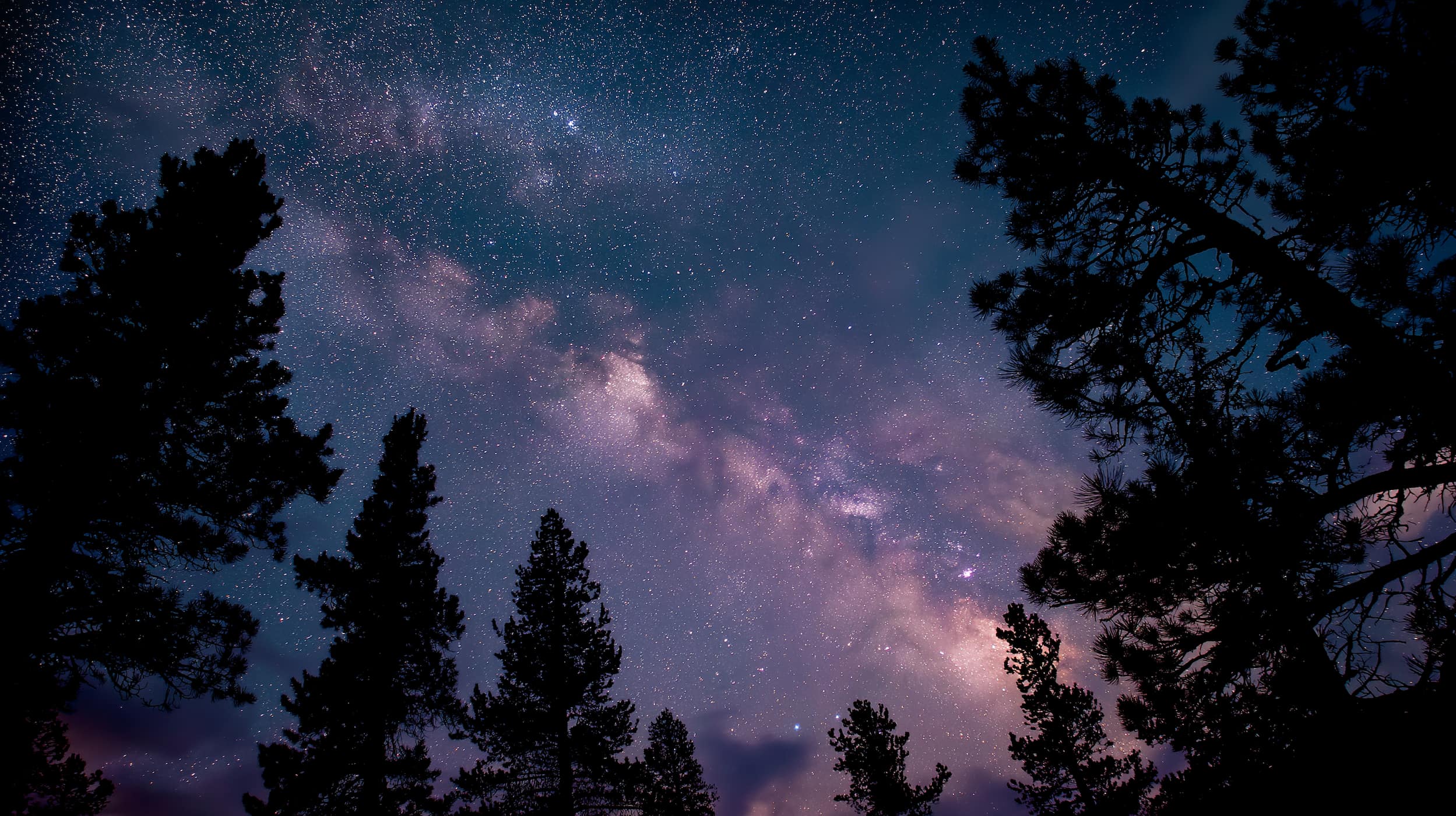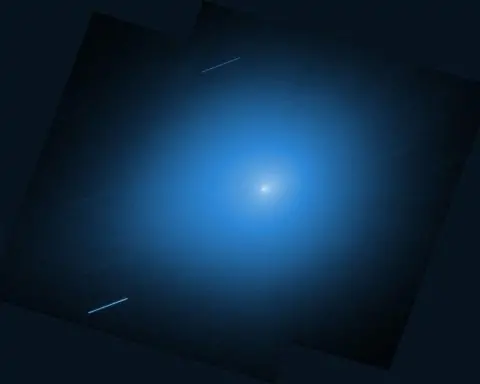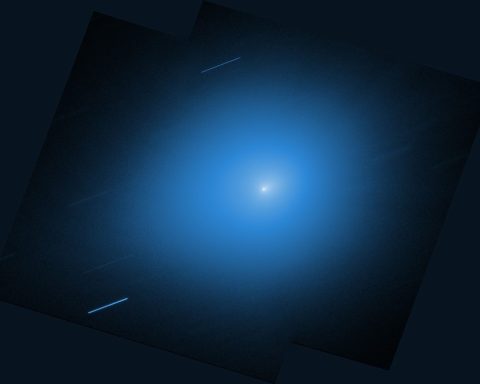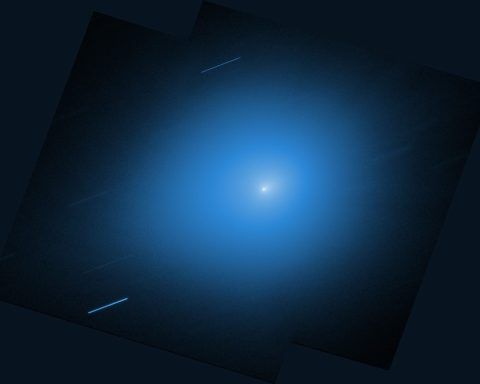- The Black Moon occurs when the new moon reaches Aug 23 at 06:06 UTC, making it the third of four summer 2025 new moons (June 25, July 23, Aug 23, Sept 21) and rendering a moonless sky.
- The Perseid meteor shower, which peaked in mid-August with up to about 100 meteors per hour under ideal conditions, is winding down by Aug 23, but a Moonless sky this weekend could yield roughly 5 meteors per hour with occasional bright fireballs.
- The minor Kappa Cygnids (Aug 3–28, peaking around Aug 16) remain active with at most about 3 meteors per hour at peak, radiating from Cygnus near Kappa Cygni and producing bright, slow-moving fireballs.
- With the Moon absent, the summer Milky Way is visible at night, including the Milky Way center in Sagittarius, the Andromeda Galaxy high in the east, and the Summer Triangle framing star clusters and nebulae.
- Venus (magnitude -4) and Jupiter are bright in the eastern dawn, with Mercury near the horizon about 30–40 minutes before sunrise around Aug 23–24, and observers are advised to start looking about 45 minutes before local sunrise.
- Mars is visible in the western twilight at about magnitude +1.8, fading since May and setting an hour or two after sunset, with the crescent Moon joining Mars on Aug 26.
- Saturn is visible all night, rising around 9–10 p.m., shining near magnitude +0.6 in Aquarius, and offering a view of its rings (and Titan with a telescope) as it heads toward its late-September opposition, with Titan’s shadow transit having occurred on Aug 18–19.
- All five naked-eye planets can be visible around this weekend: Mars at dusk, Saturn all night, and Venus and Jupiter in the dawn sky, with Mercury possibly glimpsed near the horizon.
- Auroras are not forecast for Aug 23–24, with NOAA predicting a maximum Kp of 3, though a rare late-summer glow was observed on Aug 19 at latitudes as far south as 42° in the United States.
- Predawn passes of the International Space Station (ISS) are expected around Aug 23–24, with the ISS at about 400 km altitude, visible as a bright moving dot, and tools like NASA’s Spot the Station or Heavens-Above providing exact times; Tiangong may be visible, and Starlink trains launched on Aug 17, 2025 are dispersing by Aug 23–24.
This weekend’s skies offer a cosmic extravaganza – from a rare “Black Moon” darkening the heavens to the final flickers of the Perseid meteor shower, a parade of planets in the dawn, and even a chance for Northern Lights. Here’s your comprehensive, public-friendly guide to all the celestial sights on August 23–24, 2025, and how to enjoy them under clear, dark skies.
Meteor Showers: Perseids’ Final Flickers (Plus a Few Strays)
The famous Perseid meteor shower, which peaked in mid-August, is now winding down – but it’s not over yet. The Perseids remain active until around August 23 [1], meaning you could still catch a few “shooting stars” if you’re patient. Don’t expect the frenzy of peak night (when up to ~100 meteors per hour might occur under ideal conditions) – moonlight during the peak this year hid many of the dimmer meteors [2]. Now, with the Moon out of the way, any late stragglers will stand out nicely [3] against the dark sky. In fact, even a week after the peak “occasional bright Perseid fireballs are possible”, since this shower is known for spectacular streaks that can leave glowing trails [4]. Meteor expert Robert Lunsford of the American Meteor Society noted that during the moonlit peak, “the best rates [at Perseid peak] will probably be near 15 per hour as dim meteors… are hidden” [5] – but now, under Black Moon darkness, even those remaining few per hour should be easier to spot. In practical terms, expect at most a handful of meteors per hour under good conditions (perhaps ~5 per hour) [6], mostly the brighter ones that can still streak by.
Don’t forget: to see meteors, find a dark location away from city lights and let your eyes adjust. Give it at least an hour of watching – meteors tend to come in spurts, with lulls in between. Lie back, scan the sky, and be patient [7] [8]. “Allow your eyes at least 20 minutes to adjust to the dark, and avoid looking at bright screens or flashlights,” experts advise [9]. The best time is late night into the pre-dawn hours (after local midnight, when Earth is facing into the meteor stream) [10]. And while Perseids can appear anywhere in the sky, their trails will point back to the northeastern sky (the constellation Perseus).
What about other meteor activity? Late August doesn’t only belong to the Perseids. A minor shower called the Kappa Cygnids is also active (roughly Aug 3–28, peaking around Aug 16) [11]. Don’t expect big numbers – at most ~3 meteors per hour at peak [12], and even fewer now – but the Kappa Cygnids are famous for bright, slow-moving fireballs that can surprise observers [13]. If you see an especially slow, long-lasting meteor this weekend that doesn’t match a Perseid’s path, you might have spotted one of these Cygnid fireballs [14]. The Kappa Cygnid meteors appear to radiate from the constellation Cygnus (near the star Kappa Cygni) high overhead in the evening for mid-northern latitudes [15].
Global viewing note: Meteor showers favor the Northern Hemisphere this time of year. The Perseid radiant rises high in the north (in Perseus) past midnight, whereas in the Southern Hemisphere it stays very low or below the horizon – so southern skywatchers will see far fewer Perseids [16]. Similarly, the Kappa Cygnid radiant in Cygnus is essentially out of view for far-southern latitudes [17]. Northern observers, especially those in dark rural areas, have the advantage for catching both Perseids and the odd Cygnid. If you’re in the Southern Hemisphere, you might only catch a rare Perseid earthgrazer skimming the horizon, but you can still enjoy the splendid Milky Way (more on that below). Either way, bundle up, get comfortable (a reclining chair or blanket helps), and keep watching – you may also spot a few random “sporadic” meteors unrelated to any shower, which zip across the sky on any given night [18].
Rare Black Moon and Lunar Highlights
The Moon is the headline act this weekend – ironically by not showing up! On August 23, the Moon reaches its new moon phase at 06:06 UTC (2:06 a.m. EDT) [19], marking an especially rare Black Moon. A “Black Moon” isn’t a spooky visual phenomenon – in fact, you won’t see the Moon at all that night – but an unusual calendrical event. It refers to an “extra” new moon in a season that normally has only three [20]. In this case, summer 2025 in the Northern Hemisphere has four new moons (June 25, July 23, Aug 23, and Sept 21), making the Aug 23 new moon the third of those four – the Black Moon [21] [22]. These seasonal Black Moons happen only about once every 33 months (the last one was in May 2023) [23] [24]. Another definition of “Black Moon” – the second new moon in a calendar month – doesn’t apply this time (that won’t occur until 2027) [25].
So what does a Black Moon mean for skywatchers? Darkness, and lots of it. During a new moon, our natural satellite is positioned between Earth and the Sun, with its illuminated side facing away from us [26]. It rises and sets roughly with the Sun and becomes essentially invisible against the daytime sky (unless it causes a solar eclipse, which this one does not) [27]. As a result, the night of Aug 23/24 will be moonless, offering exceptionally dark skies all night long. This is a boon for observing faint stars, meteor showers, and the Milky Way’s dense core, which are often washed out by moonlight [28] [29]. If you have access to a dark-sky location, take advantage – the summer Milky Way (stretching across Sagittarius, Scorpius, and Cygnus overhead) is at its brightest and most detailed now, and without moonlight you can see myriad stars, star clusters, and nebulae on a clear night.
While the Black Moon itself is invisible, keep an eye on the western sky after sunset on Aug 24 and 25. In the days immediately following a new moon, a breathtakingly thin crescent becomes visible at dusk. 30–40 minutes after sunset on Sunday Aug 24, look low toward the western horizon for a delicate silver sliver – that’s the young Moon returning [30] [31]. Only about 1–2% of the Moon’s disk is illuminated that evening [32], so it will be an ultra-thin arc, “a thin, delicate crescent” in the twilight [33]. If you miss it, try again on Monday Aug 25; the crescent will be slightly higher and a bit thicker (around 5% lit). Catching a 1-day-old Moon is a fun challenge even for seasoned observers – bring binoculars if you have trouble spotting it in the glow of sunset. As dusk falls further, you might also notice the rest of the Moon’s outline faintly glowing with “earthshine” (sunlight reflected from Earth dimly lighting the Moon’s dark side).
These first few evenings of the waxing crescent are also an opportunity to witness the Moon’s journey past the stars and planets. By Tuesday Aug 26, the growing crescent will appear near Mars in the west after sunset [34] (more on that conjunction below). And each night thereafter, the Moon will climb higher and brighten on its way to first quarter by the end of August. No eclipses are happening during this period – the next significant lunar event will be a total “Blood Moon” lunar eclipse on Sept 7, 2025 [35], but for this weekend the focus is the invisible new moon and its beautiful crescent encore.
Bottom line: The Black Moon on Aug 23 means ideal stargazing conditions this weekend. Take the opportunity to seek out faint sights: the Andromeda Galaxy is visible high in the east by late night, the Summer Triangle stars frame numerous star clusters and nebulae, and the Milky Way’s center (toward Sagittarius) will be richly detailed on these moonless nights [36]. Just be sure to find a dark site and let your eyes adapt to fully enjoy the dark-sky wonders.
Planets on Parade: Dawn Trio and All-Night Saturn
Several planets are putting on a show, from dusk till dawn. Here’s where to find the naked-eye planets this weekend:
- Venus & Jupiter at Dawn: Early risers are in for a treat – the two brightest planets, Venus and Jupiter, are shining prominently in the eastern sky before sunrise. Venus has recently returned to the morning sky and is gleaming extremely bright (magnitude –4) roughly 20–30° above the horizon in the east during the predawn hours [37]. Jupiter is also visible in the east nearby – much fainter than dazzling Venus, but still one of the brightest points in the morning sky [38]. Earlier in the month, Venus and Jupiter had a close conjunction on Aug 11–12. By Aug 23–24 they have separated a bit, but are still relatively close together in the sky, making for a striking pair at dawn. Venus will be the unmistakable beacon of dawn, and Jupiter will appear higher and to Venus’s right, shining steadily (with a pale yellow-white hue). If you have a very clear, flat horizon, you might also catch Mercury rising below them – see below!
- Mercury’s Morning Appearance:Mercury, the innermost planet, is notoriously tricky to spot, but late August offers a chance. On Aug 19 Mercury reached its greatest elongation (apparent distance) from the Sun, which means it’s as far from the Sun’s glare as it gets and briefly visible in the morning sky [39]. Around Aug 23–24, Mercury is still hanging low in the eastern dawn about 30–40 minutes before sunrise. Look for a modestly bright star-like point very close to the horizon in the east-northeast, below Venus and Jupiter. You’ll likely need binoculars and an unobstructed view (since Mercury never climbs high) – but if you find it, you’re catching a planet that many people have never seen with the naked eye! Tip: Start looking ~45 minutes before your local sunrise time and scan the horizon for Mercury; it will fade out as the sky grows brighter. (Make sure to stop looking once the Sun is about to rise to avoid eye damage.) For about a week after Aug 19, Mercury, Venus, and Jupiter form a loose diagonal line at dawn – a mini planetary alignment in the morning twilight [40]. Seeing all three at once is a rewarding sight – Mercury close to the horizon, brilliant Venus higher up, and Jupiter above Venus.
- Mars at Dusk: Over in the evening sky, Mars is making a quiet exit. The red planet is now far from Earth and has dimmed considerably (to about magnitude +1.8, only ~60% as bright as it appeared back in May) [41]. You can spot Mars low in the west after sunset, during twilight, but you’ll need a clear view and perhaps binoculars. It appears as a modest orange-red “star” low on the horizon, setting roughly an hour or two after the Sun [42]. Mars is currently drifting in the constellation Virgo. On Aug 26, as mentioned, the young crescent Moon will join Mars, which may help locate it – the Moon will be just to the left of Mars shortly after sunset that evening [43]. For Aug 23–24, though, Mars will be alone in the fading glow. If you haven’t seen Mars recently, don’t expect a bright beacon – it’s relatively faint now – but it’s still fun to say hello to the Red Planet before it disappears behind the Sun’s glare in the coming weeks.
- Saturn – Ringed Jewel All Night:Saturn is the star of the late-night sky this month. The ringed planet is nearing its opposition (which will occur in late September), meaning it’s almost at its biggest and brightest for 2025 [44]. Already, Saturn is visible all night long: it rises in the east by mid-evening (around 9–10 p.m. local time in late August) and soars high in the south by midnight, remaining up until dawn [45]. Look for a steady, golden-yellow point of light in the constellation Aquarius (near the eastern side of Capricornus) – that’s Saturn. It shines at roughly magnitude +0.6 now [46], so it’s as bright as a prominent star, though not as bright as Jupiter or Venus. If you have a telescope, this is a great time to observe Saturn’s stunning rings and its brightest moons. Even binoculars might show a hint of Saturn’s oval shape or Titan (Saturn’s largest moon) nearby. Around opposition the planet’s rings also show a seeliger effect (a temporary brightening), so Saturn may appear a touch brighter than usual. Fun fact: on August 18–19, observers with telescopes could witness Titan’s shadow transit across Saturn’s cloud tops – a rare event [47]. While that specific event has passed, it highlights that Saturn is currently well-placed for observation. Saturn’s presence also anchors the evening sky: as it rises earlier each night, it becomes a prominent late-summer fixture. Don’t miss Saturn beaming in the southeast in the evening and shifting to the west by dawn.
- All Five Planets in One Night: If you’re ambitious, all five naked-eye planets can be observed around this weekend with some timing strategy. Mars pops out briefly at dusk in the west. Saturn comes up in the east by evening and is visible through the night. In the hours before dawn, Jupiter and Venus dominate the eastern sky, and Mercury may be glimpsed at the horizon. By dawn’s early light, Saturn will be descending in the west while the other three shine in the east, meaning at least four planets are visible at once (Saturn in the west; Venus, Jupiter, Mercury in the east). This effectively creates a broad “planet parade” spread across the sky. It’s not a tight grouping, but it is remarkable to know that in one late-night span you can see Mercury, Venus, Mars, Jupiter, and Saturn – a true solar system sampler! (Uranus and Neptune are up there too – Neptune near Saturn in Aquarius, and Uranus in Aries before dawn – but you’d need a telescope or binoculars to spot those).
Keep in mind that planet visibility varies by hemisphere as well, though in late August both Northern and Southern Hemisphere observers can see all these planets (the difference is the angle above the horizon). In the Southern Hemisphere, Venus and Jupiter will appear a bit lower in your dawn sky (winter mornings), and Mars even lower at dusk, but Saturn will be nicely placed high overhead at midnight. Wherever you are, planets don’t twinkle like stars – so if you see a steady, non-twinkling light, you’ve likely found one. Enjoy identifying these distant worlds with the unaided eye, and consider pointing a telescope at Saturn or Jupiter for an even more impressive view (Jupiter’s moons and cloud belts, and Saturn’s rings, are visible in small scopes).
Auroras & Space Weather: Any Northern Lights?
Skywatchers are still buzzing from a surprise aurora display earlier this week. On the night of August 19, a minor geomagnetic storm gave an unusually far-reaching Aurora Borealis show. The U.S. Space Weather Prediction Center (SWPC/NOAA) had forecast a G1-class geomagnetic storm (Kp index ~5) for that night, and indeed the Northern Lights dipped much farther south than usual – as far south as ~42° latitude in the United States [48]. People reported auroral glows or pulsating green and purple curtains from states like Montana, North Dakota, Minnesota, Wisconsin, Michigan, New York, Vermont, New Hampshire, Maine, and even northern Illinois and Iowa on the horizon [49]. Seeing auroras in the Lower 48 at the height of summer is rare (normally you’d need a stronger G3/G4 storm for that) [50] [51], so this was a notable event – essentially a “rare summer light show” delivered by a relatively minor solar storm. Across the globe, similar aurora activity was observed at high latitudes – for instance, southern Canada, Northern Europe (Scotland, Scandinavia), and likely in the Southern Hemisphere at equivalent geomagnetic latitudes (such as New Zealand’s South Island and Tasmania, where the Aurora Australis would have been visible low on the horizon).
What caused it? Space weather forecasters pointed to a combination of solar events: a large coronal hole on the Sun that had been spewing a high-speed stream of solar wind toward Earth, plus a small coronal mass ejection (CME) that delivered a “glancing blow” to Earth’s magnetic field around Aug 19–20 [52] [53]. This one-two punch of fast solar wind and a minor CME was enough to disturb Earth’s magnetosphere and push auroras into unusually low latitudes for a G1 storm [54] [55]. In essence, we got brief geomagnetic fireworks thanks to the Sun’s increasing activity. (It’s worth noting: the Sun is approaching the peak of its 11-year cycle in 2025, and solar activity – sunspots, flares, and geoeffective coronal holes – has been ramping up. NOAA notes that as we head into 2025–26, we can expect more frequent auroral displays as a result [56] [57].)
For the August 23–24 period, however, no major geomagnetic storm is predicted. The energy from the Aug 19 solar wind stream has dissipated, and as of now the geomagnetic forecast is fairly quiet. NOAA’s 3-day aurora outlook indicates at most Kp 3 (“active” levels) expected through Aug 24, which is below the G1 storm threshold [58]. In other words, no aurora watch or warning is in effect for the weekend, and significant Northern Lights activity is unlikely unless the Sun throws an unexpected surprise. Of course, in the dynamic space-weather environment, things can change if a sudden solar flare or CME occurs – but none is anticipated at the moment. Space-weather agencies like NOAA and the U.K. Met Office are continuously monitoring the Sun. (Just a few days ago, on Aug 21, a speedy CME blasted off – but from the far side of the Sun, so it won’t impact Earth [59].) For now, Earth’s magnetic field is expected to stay mostly calm over the Aug 23–24 interval.
What does this mean for aurora watchers? If you’re at high latitudes – say, the far northern U.S. (Upper Midwest, New England, Alaska), Canada, northern Europe, or similarly far-south locations in the Southern Hemisphere – you might still see faint auroral glows given sufficiently dark skies, but a big display is not anticipated. It never hurts to check the aurora oval forecasts: NOAA’s SWPC has an online Aurora Dashboard with maps of the auroral zone and aurora strength in real time [60] [61]. As of this writing, those maps show the aurora confined to high latitudes (within Canada/Scandinavia, etc.). So for most readers, this weekend likely won’t bring a widespread aurora event – but keep in mind the Sun is active, and surprise geomagnetic upticks can happen if an unforecasted solar burst occurs. If you’re in a location like Iceland, Norway, Alaska, or Tasmania, it’s always worth a quick check of the northern/southern horizon on a dark, clear night just in case a subtle auroral glow is present.
Also, with late August comes the start of the traditional “aurora season” in higher latitudes. Nights are growing longer again after the summer solstice, allowing any auroras that do occur to be seen. In fact, aurora tour guides note that March–April and August–September are often great periods for aurora activity due to seasonal geomagnetic effects. The Southern Lights (Aurora Australis) also tend to be most visible during the Southern Hemisphere’s winter months (May–August) [62], so we’re just at the tail of that window. So even though no specific aurora storm is forecast for Aug 23–24, avid aurora chasers should stay alert as we approach the equinox – historically, geomagnetic activity can spike around the September equinox (the so-called Russell-McPherron effect). In short, stay tuned to space weather alerts if you’re keen on the Northern or Southern Lights, and have your camera ready if a surprise green glow shows up on the horizon.
Expert tip: If an aurora is expected (even a minor one), try to get away from city lights and find a spot with a clear view of the northern sky (or southern sky if you’re in the Southern Hemisphere). Even a minor aurora can be washed out by light pollution, or hidden by clouds, so dark clear skies are key [63] [64]. Auroras often appear as a faint whitish or greenish “cloud” to the naked eye, which long-exposure photos reveal as vibrant curtains of green, purple, or red. The best time to check is usually around local midnight to the pre-dawn hours, when geomagnetic activity often peaks [65]. And remember, aurora viewing is a patience game – nothing may happen for hours, then a brief burst of shimmering light could dance for a minute and fade. If you’re within the auroral zone, keep watch periodically. But for this weekend, manage your expectations: the quiet Sun means the celestial highlights will likely be meteors and dark skies, rather than auroras, unless Mother Nature pulls a fast one.
The International Space Station & Satellite Sights
Not all the action in the night sky is from Mother Nature – human-made satellites are also visible if you know when to look. Chief among these is the International Space Station (ISS), which regularly makes spectacular passes overhead. The ISS is a bus-sized spacecraft orbiting ~400 km above Earth, inhabited by astronauts, and it can outshine most stars when it catches the Sun’s light. As NASA describes, the station typically appears “similar to an airplane or a very bright star moving across the night sky, except it does not have flashing lights” [66]. It shines with a steady white glow, taking a few minutes to cross the sky.
Around August 23–24, the ISS’s orbit is producing predawn passes for many mid-latitude locations. In mid-August, the ISS had multiple early-morning flyovers visible across parts of North America and Europe [67]. That pattern has been continuing, so if you’re an early riser, check for potential ISS sightings in the hour or two before sunrise. (The general rule: ISS sightings occur near dawn or dusk – when your sky is dark but the station is still sunlit high above [68].) For example, in the past week, skywatchers in cities like Warsaw and New York enjoyed bright ISS passes around 4–5 AM local time [69]. As the ISS orbit shifts, some locations may also get evening passes after sunset.
Because the ISS moves fast (circling Earth ~16 times a day, with each orbit ~90 minutes [70]), the specific timing of a pass depends on your location. To find out if the ISS will fly over your area this weekend, use tools like NASA’s “Spot the Station” service or the Heavens-Above website [71]. These services will give you exact times, directions, and elevation angles to look. Typically, an ISS pass will appear as a bright moving “star” rising in the west or northwest, cruising across the sky, and disappearing in the east or southeast (or sometimes vanishing into Earth’s shadow partway through the pass). The station can get extremely bright (rivaling Venus at its peak), especially if it passes near overhead [72] [73]. If you catch one of these flyovers, give a wave – there are currently astronauts aboard (Expedition 70 crew in August 2025) living and working in that bright dot of light [74].
Aside from the ISS, many other satellites can be seen if you spend a while gazing at the night sky. You might notice dimmer objects gliding along – these could be anything from communication satellites to space debris. A few are particularly worth looking out for:
- Tiangong Space Station (China): China’s own space station, Tiangong, is smaller and usually a bit dimmer than the ISS, but under dark skies it can be visible as a steady moving point of light (no blinking lights) [75]. Its orbit is different from the ISS, so it might be visible on different schedules – you can check for Tiangong passes on satellite tracking websites as well.
- Starlink “Trains”: SpaceX’s Starlink satellites, launched in batches, can sometimes create a fascinating “train” of lights shortly after launch. In fact, a Falcon 9 launch on Aug 17, 2025 deployed a new batch of Starlink satellites [76]. In the days after launch (around Aug 18–20), observers reported seeing a string of faint lights crossing the sky – those were the newly launched Starlinks still clustered together [77]. By Aug 23–24, that cluster will have dispersed and grown dimmer as the satellites raise their orbits, so a distinct train is less likely. Still, if you’re under a very dark sky, you might catch multiple satellites in the same orbit following each other. They won’t be as bright as the ISS, and often you’ll need to know exactly when to look. (Heavens-Above can also show Starlink passes for your area.) Starlink “trains” have generated intrigue and also concern among astronomers for their impact on the night sky. But casual observers often find it pretty cool to see a parade of lights moving in unison.
- Other Satellites & Flares: Random satellites are everywhere. Some might “flare” briefly if their solar panels reflect sunlight directly at you – the defunct Iridium satellites used to do this regularly, creating brilliant flashes called Iridium flares. Those specific flares are now mostly history (since Iridium satellites were retired), but occasionally other spacecraft produce glints. For example, rocket bodies or old boosters tumbling in orbit can flash as they rotate. If you see a brief flash or a satellite that brightens and dims periodically, that could be a tumbling object catching the light.
Keep in mind that satellites generally move steadily in a straight line, taking a few minutes to cross the sky. If it blinks or has red/green flashing lights, that’s an airplane, not a satellite. The ISS and bright satellites won’t blink – they shine with constant sunlight (until they slip into Earth’s shadow and fade out abruptly). To distinguish the ISS from aircraft: the ISS has no blinking lights and usually moves faster across the sky than high airplanes, and it appears as a single very bright point [78] [79]. It also doesn’t leave any contrails, of course.
Finally, a fun note: occasionally, rocket launches or reentries can be visible events too. There are no major launches specifically timed for the nights of Aug 23–24 that would produce visible effects, but it’s always worth keeping an ear out. For example, earlier in the week a large rocket stage was predicted to reenter the atmosphere, and observers in the right area might have seen a spectacular fireball-like streak as it broke up (these events are usually only announced with short notice) [80]. No such scheduled reentries are expected this weekend, but space news can surprise us.
In Summary: Enjoy the Show!
With no Moon in the sky, late August 2025 offers prime conditions to enjoy the night. Highlights for Aug 23–24 include the vanishing Moon (Black Moon) leading to excellent stargazing, the tail end of the Perseid meteors (plus a few extra fireballs from minor showers), a brilliant planetary showcase (especially in the morning sky with Venus, Jupiter, Mercury, and an all-night Saturn), and the general splendor of the summer Milky Way overhead. While auroras aren’t specifically forecast to dance this weekend, the auroral oval is always glowing up north – so if you’re in a far northern (or southern) location, it’s worth a look just in case.
All of these phenomena are observable with the naked eye – no fancy equipment needed – though binoculars or a small telescope can enhance certain views (like Jupiter’s moons, Saturn’s rings, or craters on the crescent Moon). Most importantly, clear skies are a must, so check your local weather and find a clear night. If clouds interfere on one night, try the next night. Plan to be out at the right times: after sunset for the young Moon and Mars, late evening for general stargazing and Saturn, after midnight for meteors (and deepest Milky Way views), and pre-dawn for the planet lineup (and any last meteors). You might want to take advantage of the weekend by camping or visiting a nearby dark-sky park – the difference away from city lights can be jaw-dropping [81].
Lastly, keep an eye on reputable astronomy news sources (NASA, NOAA, Spaceweather.com, etc.) for any up-to-the-minute alerts – whether it’s a surprise comet, a solar flare, or an aurora forecast. But even without any unexpected events, the celestial routine this weekend is plenty exciting. From the rare Black Moon that opens the stage, to the final Perseid wish-makers, wandering planets, and the glowing cosmic river of the Milky Way, there’s something for everyone up there. So spread a blanket, look up, and enjoy a magical summer night under the stars!
Clear skies! 🔭✨
Sources: Connected observations and forecasts from NASA [82] [83], NOAA and space weather centers [84] [85], the American Meteor Society [86], Space.com and EarthSky news reports [87] [88], and expert commentary from astronomers [89] [90]. (All cited content is referenced in context above.) Enjoy the show!
References
1. ts2.tech, 2. ts2.tech, 3. ts2.tech, 4. ts2.tech, 5. ts2.tech, 6. ts2.tech, 7. ts2.tech, 8. ts2.tech, 9. ts2.tech, 10. ts2.tech, 11. ts2.tech, 12. ts2.tech, 13. ts2.tech, 14. ts2.tech, 15. ts2.tech, 16. ts2.tech, 17. ts2.tech, 18. ts2.tech, 19. www.space.com, 20. www.space.com, 21. www.space.com, 22. www.wbiw.com, 23. www.space.com, 24. www.wbiw.com, 25. www.space.com, 26. www.space.com, 27. www.space.com, 28. www.space.com, 29. www.wbiw.com, 30. www.space.com, 31. www.wbiw.com, 32. theskylive.com, 33. www.wbiw.com, 34. www.space.com, 35. www.space.com, 36. www.space.com, 37. science.nasa.gov, 38. science.nasa.gov, 39. www.travelandleisure.com, 40. www.travelandleisure.com, 41. science.nasa.gov, 42. science.nasa.gov, 43. www.space.com, 44. starwalk.space, 45. science.nasa.gov, 46. starwalk.space, 47. ts2.tech, 48. ts2.tech, 49. ts2.tech, 50. ts2.tech, 51. ts2.tech, 52. ts2.tech, 53. ts2.tech, 54. ts2.tech, 55. ts2.tech, 56. ts2.tech, 57. ts2.tech, 58. www.swpc.noaa.gov, 59. www.spaceweather.com, 60. ts2.tech, 61. ts2.tech, 62. www.trafalgar.com, 63. ts2.tech, 64. ts2.tech, 65. ts2.tech, 66. ts2.tech, 67. ts2.tech, 68. ts2.tech, 69. ts2.tech, 70. ts2.tech, 71. ts2.tech, 72. ts2.tech, 73. ts2.tech, 74. ts2.tech, 75. ts2.tech, 76. ts2.tech, 77. ts2.tech, 78. ts2.tech, 79. ts2.tech, 80. ts2.tech, 81. ts2.tech, 82. science.nasa.gov, 83. science.nasa.gov, 84. www.swpc.noaa.gov, 85. ts2.tech, 86. ts2.tech, 87. www.space.com, 88. ts2.tech, 89. ts2.tech, 90. ts2.tech










